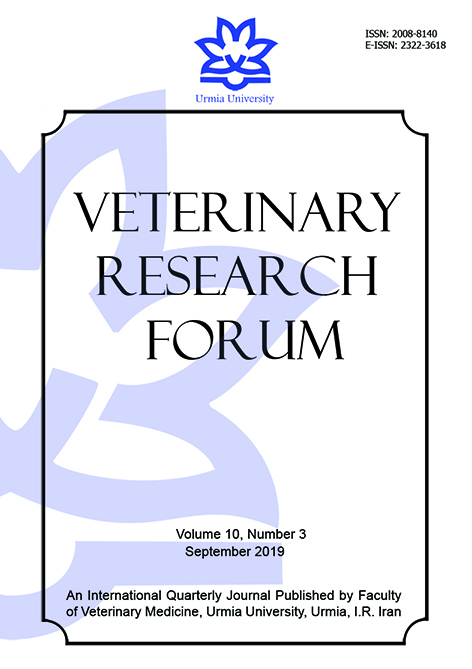Document Type : Original Article
Authors
1 Department of Food Hygiene, Faculty of Veterinary Medicine, Semnan University, Semnan, Iran
2 PhD Candidate, Department of Food Science and Technology, North Tehran Branch, Islamic Azad University, Tehran, Iran
3 Department of Food Science and Technology, Varamin-Pishva Branch, Islamic Azad University, Varamin, Iran
Abstract
Natural compounds including essential oils (EOs) are used to inhibit the pathogenic bacterial growth in foods. The objective of this study was to investigate the combined effect of Trachyspermum ammi EO and propolis ethanolic extract (PEE) on some food pathogenic bacteria. In this study, the effect of T. ammi EO and PEE at different concentrations, individually and in combination, on Escherichia coli, Salmonella typhimurium, Listeria monocytogenes, Bacillus cereus, and Staphylococcus aureus were investigated using minimum inhibitory concentration and fractional inhibitory concentration (FIC) indices. Moreover, the effect of sub-inhibitory concentrations of EO and extract on E. coli and S. aureus growth curve was determined. The results revealed the synergistic effect of T. ammi EO and PEE on S. aureus, B. cereus, E. coli, S. typhimurium, and L. monocytogenes. The effects of EO and extract sub-inhibitory concentrations on bacterial growth curve resulted in an increased lag phase of the culture and decelerated bacterial growth, especially S. aureus. The results showed that T. ammi EO and PEE, especially when combined, are effective in bacterial growth inhibition and their potential use in food systems is recommended.
Keywords
Main Subjects
- Jebelli-Javan A, Ghazvinian K, Mahdavi A, et al. The effect of dietary Zataria multiflora Boiss. essential oil supplementation on microbial growth and lipid peroxidation of broiler breast fillets during refrigerated storage. J Food Process Preserv 2013; 37(5): 881-888.
- Gandomi H, Abbaszadeh S, Jebelli-Javan A, et al. Chemical constituents, antimicrobial and antioxidative effects of Trachyspermum ammi essential oil. J Food Process Preserv 2014; 38(4): 1690-1695.
- Lubbe J, Sanchez‐Politta S. Propolis, beeswax, and the sensitization potential of topical calcineurin inhibitors. Clin Exp Dermatol 2006; 31(1): 147-148.
- De Vecchi E, Drago L. Propolis' antimicrobial activity: What’s new? Infez Med 2007; 15(1): 7-15.
- Hamouda A, Elbanna H. Combined antimicrobial effect against some isolated bacteria from chickens. J Phys Pharm Adv 2013; 3(12): 272-276.
- Adams RP. Identification of essential oil components by gas chromatography/mass spectroscopy. 4th ed. New York, USA: Allured Publishing Corporation1997;9-31.
- Schwalbe R, Steele-Moore L, Goodwin AC. Anti-microbial susceptibility testing protocols. USA: Taylor and Francis Group CRC Press 2007; 75-81.
- Santiesteban‐Lopez A, Palou E, Lopez‐Malo A. Susceptibility of food‐borne bacteria to binary combinations of antimicrobials at selected aw and pH. J Appl Microbiol 2007; 102(2): 486-497.
- Ataee M, Hosseini H, Noori N, et al. Effect of Zataria multiflora Boiss. essential oil on growth curve and shigatoxin 2 production of enterohemorrhagic E. coli O157: H7. J Med Plants 2013; 4(48): 62-71.
- Alpsoy L. Inhibitory effect of essential oil on aflatoxin activities. Afr J Biotechnol 2010; 9(17): 2474-2481.
- Gill AO, Holley RA. Interactive inhibition of meat spoilage and pathogenic bacteria by lysozyme, nisin and EDTA in the presence of nitrite and sodium chloride at 24 ˚C. Int J Food Microbiol 2003; 80(3): 251-259.
- Rota C, Carraminana J, Burillo J, et al. In vitro antimicrobial activity of essential oils from aromatic plants against selected foodborne pathogens. J Food Prot 2004; 67(6): 1252-1256.
- Selim S. Antimicrobial activity of essential oils against vancomycin-resistant enterococci (VRE) and Escherichia coli O157: H7 in feta soft cheese and minced beef meat. Braz J Microbiol 2011; 42(1): 187-196.
- Kumar A, Mishra RK, Srivastava S, et al. Role of phylo-genetic analysis for anti-bacterial activity of essential oil of Trachyspermum ammi L. against water borne pathogens. Adv Environ Biol 2011; 5(6):1271-1279.
- Goudarzi GR, Saharkhiz M, Sattari M, et al. Anti-bacterial activity and chemical composition of Ajowan (Carum copticum Benth. & Hook) essential oil. J Agr Sci Tech 2010; 13: 203-208.
- Khanizadeh AM, Zaringhalam-moghadam J, Sonboli A, et al. Effects of hydroalcholic and chloroformic extracts of Salvia candidissima on hyperalgesia and edema during adjuvant-induced arthritis. Koomesh 2015; 16(2): 239-245.
- Choi Y, Noh D, Cho S, et al. Antioxidant and anti-microbial activities of propolis from several regions of Korea. LWT-Food Sci Technol 2006; 39(7): 756-761.
- Yaghoubi SMJ, Ghorbani GR, Soleimani Zad S, et al. Antimicrobial activity of Iranian propolis and its chemical composition. Daru 2007; 15(1): 45-48.
- Rahman MM, Richardson A, Sofian-Azirun M. Antibacterial activity of propolis and honey against Staphylococcus aureus and Escherichia coli. Afr J Microbiol Res 2010; 4(18): 1872-1878.
- Siripatrawan U, Vitchayakitti W, Sanguandeekul R. Antioxidant and antimicrobial properties of Thai propolis extracted using ethanol aqueous solution. Int J Food Sci Tech 2013; 48(1): 22-27.
- Singh G, Maurya S, Marimuthu P, et al. Antioxidant and antibacterial investigations on essential oils and acetone extracts of some spices. Nat Prod Rad 2007; 6(2): 114-121.
- Fu Y, Zu Y, Chen L, et al. Antimicrobial activity of clove and rosemary essential oils alone and in combination. Phytother Res 2007; 21(10): 989-994.
- Gutierrez J, Rodriguez G, Barry-Ryan C, et al. Efficacy of plant essential oils against foodborne pathogens and spoilage bacteria associated with ready-to-eat vegetables: Antimicrobial and sensory screening. J Food Prot 2008; 71(9): 1846-1854.
- Ben Arfa A, Combes S, Preziosi‐Belloy L, et al. Anti-microbial activity of carvacrol related to its chemical structure. Lett Appl Microbiol 2006; 43(2): 149-154.

